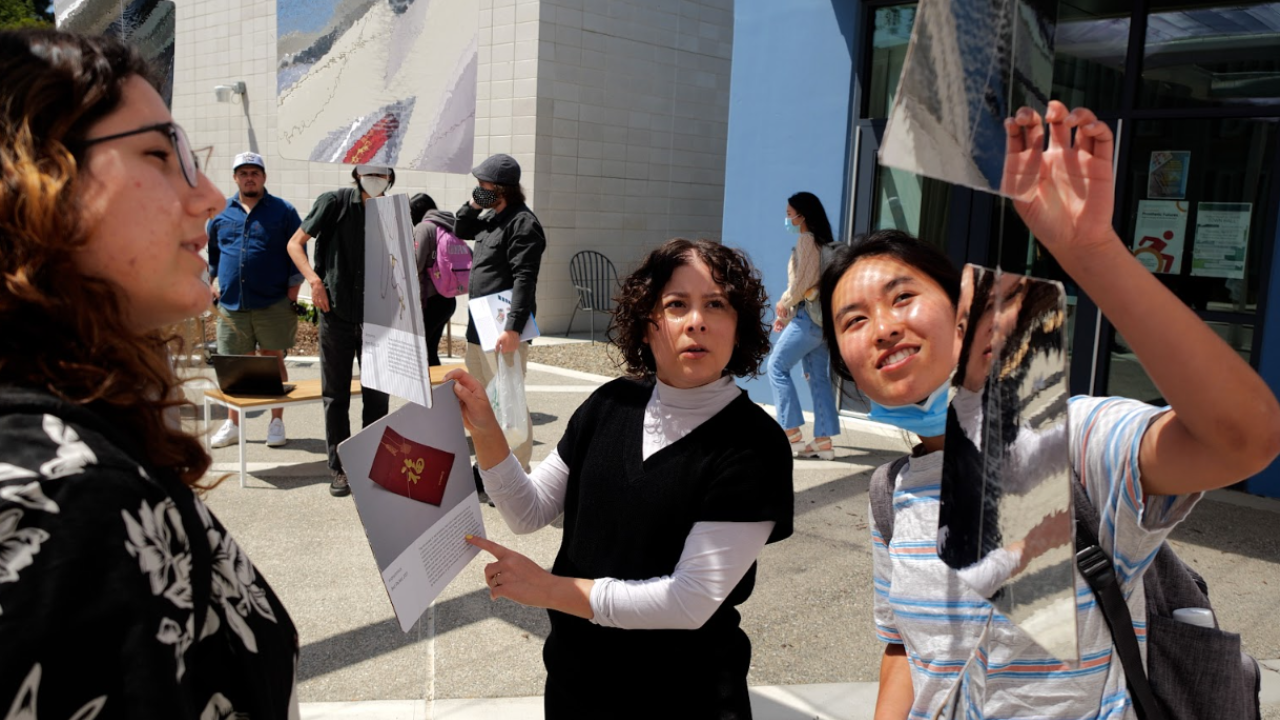
Make an Exhibition: First-Generation College Student Experiences
First-Year Seminars allow undergraduates to explore exciting and intriguing topics through interactive, hands-on experiences. One Spring 2022 seminar developed by Department of Design faculty member Tim McNeil and graduate student Edward Whelan, “Make an Exhibition: First-Generation College Student Experiences,” utilized the topic of museum exhibition design to do just that! The seminar sought to allow students to explore such exhibition environments as narrative and communal spaces while also empowering them to create a culminating exhibition around their own first-generation college student experiences at UC Davis. The primary reasoning behind this objective was to encourage these students to gain more confidence in using their narrative voices through the medium of such exhibition design. Overall, the students had a chance to eventually:
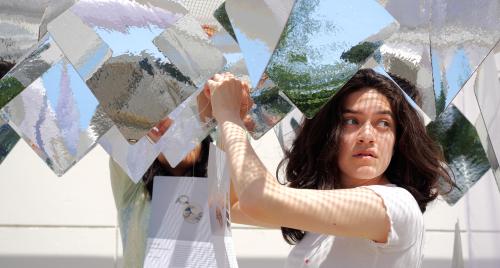
- Learn design principles relating to information and cultivate effective communication skills
- Cultivate ethics, responsibility, honor, acceptance, respect, and empathy through nature-centered design techniques
- Develop interviewing and ethnographic research skills, including organizational tools for project management
- And More!
Every week, students engaged in exploratory activities in a three-dimensional space, allowing them to brainstorm exhibition ideas by building diagrams and models, hosting in-class discussions, and completing other assignments that encouraged meaningful dialogue and artistic expression. The motivation behind each of these assignments was the idea of Story. More specifically, such activities sought to answer several questions: What stories would students like to share? What designs best tell these stories?
When reflecting on the inspiration for each seminar activity, Edward Whelan had this to emphasize:
Museums tell stories in their gallery spaces using a medium called exhibition design, but whose stories are museums telling and why? Historically, museums have been used to tell narratives of colonial strength and wealth at the expense of the subjugated and poor. These storytelling methods don’t have to be reserved for palaces and museums. They can be used to help shape and strengthen community values, identities, and relationships if more people have access to tools such as exhibition design.
After seven weeks of brainstorming stories and design, students eventually spent the last three weeks of the seminar building their final projects. Students would collaborate and implement their ideas within colorful installations located within UC Davis Arboretum. The overall exhibit was titled “Reflections & Connections” and showcased students' experiences, insights, and values in a unique fashion. Four installations were created and varied in design and meaning: a felt flower installation, an organza quilt, a community map of UC Davis, and a lotería card installation with images of UC Davis landmarks. These installations and their powerful narratives reflect the student body's care, strength, creativity, and diversity.
From Thorn to Bloom
The felt flower installation symbolizes student growth through challenges and adversity. The designers who constructed this installation provided the following description:
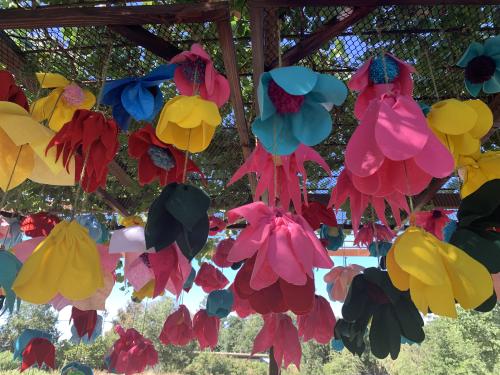
This exhibition offers a space for people who are facing challenges, such as stress from work or school. Especially during stages where they don’t feel that they have time to express their skills and interests, they can find the space to do so in our exhibit, such as crochet or sewing, and even just the activity of making flowers that everyone of all ages can do. After a period of isolation, celebrating the small wins over each of our challenges has been a challenge itself. Through “From Thorn to Bloom”, we hope to give that opportunity.
The students invited and encouraged their audience to attach their own flowers to the main exhibit so that there could be a visualization of growth and overcoming of challenges.
Aggie Family & Tradition Wall
The organza quilt installation exemplifies family traditions, serving as a window into many walks of life and cultures. The designers elaborated on their interactive quilt in-depth:
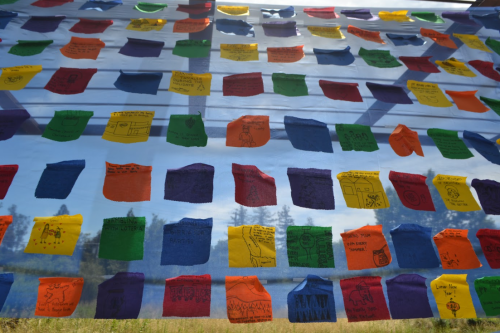
Using materials donated from the Aggie Reuse Store and other fabrics, students from the First Year Seminar “Make an Exhibition” created an interactive wall where members of the UC Davis community can share their family traditions. Each yellow square has a handwritten note or image that tells a unique story. The images are drawn on yellow fabric using fabric markers and signed with sharpie. The colors Navy Blue and Aggie Gold were chosen to show aggie pride and unite the stories on the wall.
These students also invited and encouraged their audience to create additions to the quilt, writing or drawing aspects of family traditions and celebrations present across the community.
UC Davis Map
The community map of UC Davis represents local discoveries, inspiring and encouraging discovery across Davis. The designers emphasized the inspiration behind the map itself:
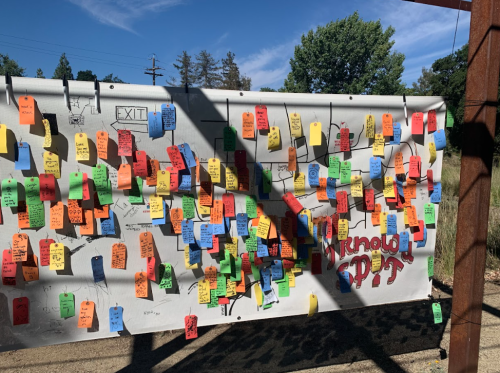
Our project was inspired by people recommending places to others, and its goal is to encourage others to visit those places. We want visitors to attach tags with written descriptions to sites they care about shown on the map. When people pass by our project, we hope to evoke a spirit of adventure and discovery by displaying stories of people's experiences in those places, inspiring them to visit those sites as well. We wish to express people's journeys as a way of discovery for people to be interested in when they come across our project. As a result, they will be introduced to new experiences.
Over the span of the exhibit, numerous passers-by would attach additional tags to the map, emphasizing locales across Davis and visualizing discovery and exploration in real-time.
UC Davis Loteria
The Loteria installation encapsulates the notion of community, symbolizing different groups and organizations across campus. The designers explained their installation further:
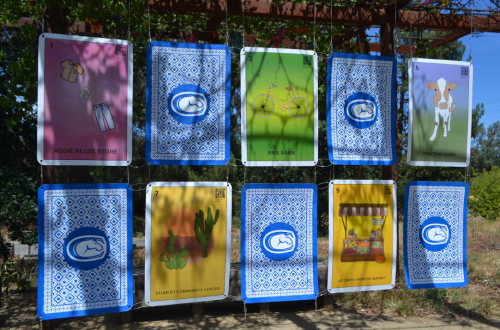
UC Davis Loteria is an Aggie version of the iconic Mexican game, Loteria. This game is similar to Bingo, but with a twist that has significant meaning to Mexican culture. The UC Davis Version of the cards displayed here symbolizes different groups and organizations that students have found community in. Each card displayed throughout the exhibition has provided a welcoming environment to first-generation students that felt alone.
The exhibit included QR codes attached to each card so that passers-by could obtain further information about each represented community, also creating a guide for first-year students.
